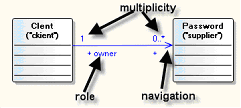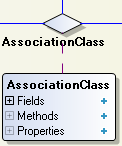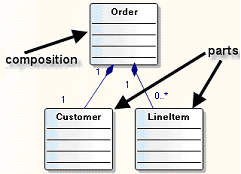Relationships Among Elements of Class Diagrams
Go Up to UML 1.5 Class Diagrams
A relationship is a connection among elements. In the Modeling, the three most important relationships are dependencies, generalizations, and associations. Graphically, a relationship is rendered as different kinds of lines used to distinguish the kinds of relationships.
Contents
Kinds of Relationships Among Elements of Class Diagrams
You can use the following kinds of relationships among elements of class diagrams:
- Generalization and implementation
- Dependency
- Association (simple association, N-ary association, aggregation, and composition)
- Provided and Required Interfaces (UML 2.0)
Generalization and Implementation
- Generalization -- A generalization is a relationship between a general element (superclass or parent) and a more specific kind of that element (subclass or child). Also a generalization is used to point the inheritance relationship between two interfaces (a child and a parent).
- Generalization means that a child inherits the properties (attributes, operations, and others) of its parents and that objects of the child element may be used anywhere the objects of the parent element may appear.
- Graphically, a generalization is rendered as a solid directed line with a large closed arrowhead, pointing to the parent:

- Implementation -- An implementation relationship is the special kind of the generalization relationship. An implementation is an inheritance link indicating that a child class implements a parent interface.
- Graphically, an implementation is rendered as a dashed directed line with a large closed arrowhead, pointing to the parent interface:

Dependency
A dependency is a relationship between two elements in which a change to one element (the independent element - supplier) causes changes to the other element (the dependent element - client).
- Graphically, a dependency is rendered as a dashed directed line, directed to the thing being depended on (supplier):

Association
A relationship between instances of two classes. There is an association between two classes if an instance of one class (client) must know about the other (supplier).
In a diagram, an association is rendered as a solid line connecting two classes.
Navigation, roles, and multiplicities are optional items placed on associations to provide clarity:
- Association Navigation. Associations can be directed or undirected. A directed link points to the supplier class (the target). A navigation arrow on an association shows the direction in which the association can be traversed or queried. A class can be queried about its "item", but not the other way around. The arrow also lets you know who "owns" the implementation of the association. Associations with no navigation arrows are bi-directional. For example, a bi-directional association between the
LibraryandBookclasses indicates that you can traverse from objects of theLibrarytype to objects of theBooktype and the other way around.
- Roles. An association has two ends. Each end can have a role name to clarify the nature of the association.
- Multiplicity. An association end can have a multiplicity. The multiplicity of an association end is the number of possible instances of the class associated with a single instance of the other end. Multiplicities are numbers or ranges of numbers.
- This table lists the most common multiplicities:
Multiplicity Meaning 0..1Zero or one instance. The notation
n..mindicatesntominstances.1ornExactly one instance or exactly
ninstances.0..*or*No limit on the number of instances (including none).
1..*At least one instance.
Types of Associations
These are the types of an association relationship:
- Association (Simple Association) -- An association ("simple association") between two peer classes. It represents a pure structural relationship between two peers. Both classes are conceptually at the same level, neither being more important than the other.
- Association (N-ary Association) -- N-ary association can connect as many association end classes (participants) as required. To create N-ary associations, use an association class.
- The Object Inspector of an association class, association link, and connector contains an additional Association tab. This tab contains only the label property, its value being synchronized with the name of the association class. For the association classes and association end links, the Custom item of the Object Inspector displays additional properties that correspond to the role of this part of n-ary association (
associationClassandassociationEndrespectively). - You can delete any of the association end links or participant classes without destroying the entire n-ary association. However, deleting the association class results in deleting all the components of the n-ary association.
- See also: Creating an Association Class.
- The Object Inspector of an association class, association link, and connector contains an additional Association tab. This tab contains only the label property, its value being synchronized with the name of the association class. For the association classes and association end links, the Custom item of the Object Inspector displays additional properties that correspond to the role of this part of n-ary association (
- Aggregation -- An aggregation is the special kind of association representing a "part-whole" relationship, in which one class represents a larger element ("whole") containing smaller elements ("parts"). A separate aggregation link is used between each class representing a part and a class representing the whole.
- This figure shows the aggregation link. The
Groupclass represents the "whole" and thePersonclass represent "parts".0..*multiplicities on both ends and theunionandmemberroles specify that eachunion(of theGrouptype) can contain any number ofmembers (of thePersontype) and, on the contrary, that eachPersontype object can be amemberof any number ofunions (of theGrouptype). The bi-directional aggregation navigation specifies that both aGrouptype object can request for itsPersontype members and aPersontype object can request for unions (of theGrouptype) of which it is a member.
- This figure shows the aggregation link. The
- Composition -- A composition is a special "strong" form of aggregation in which the "composite end" has the the total responsibility for managing its "part ends" (such as the creation and destruction of its parts).
- This figure shows the composition links. The
Orderclass represents the "composition" and theCustomerandLifeItemclasses represent "parts".
- This figure shows the composition links. The
Provided and Required Interfaces
UML 2.0 class diagrams introduce the provided and required interfaces.
To mark provided and required interfaces, UML 2.0 class diagrams use the provided interface ![]() ("lollipop" notation) and required interface
("lollipop" notation) and required interface ![]() ("soket" notation) links (see UML 2.0 Class Diagram Elements).
("soket" notation) links (see UML 2.0 Class Diagram Elements).





